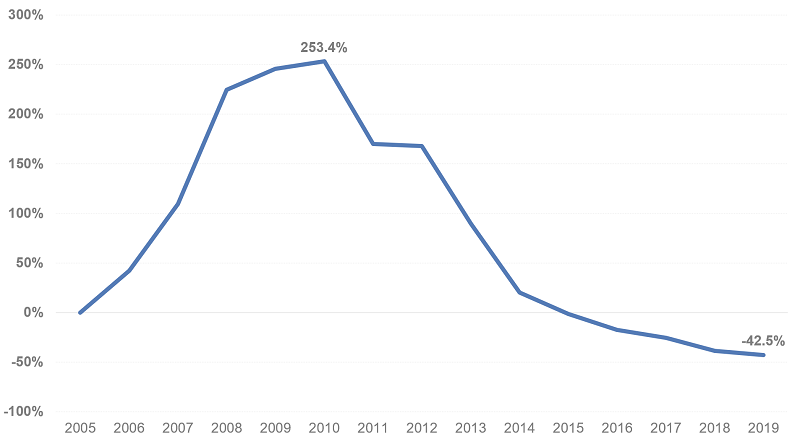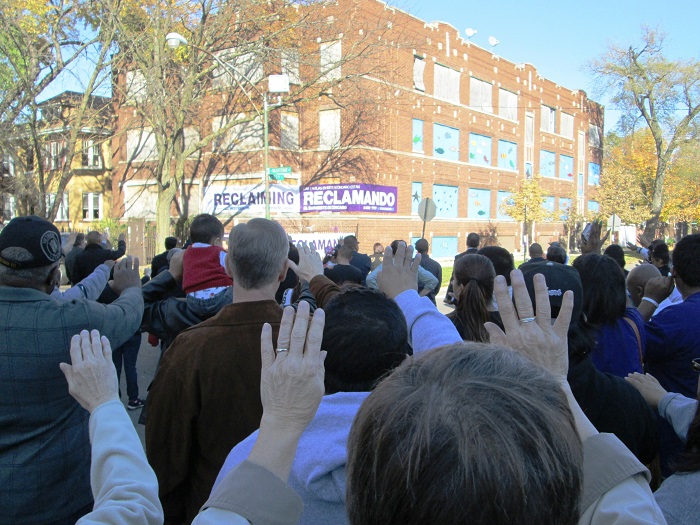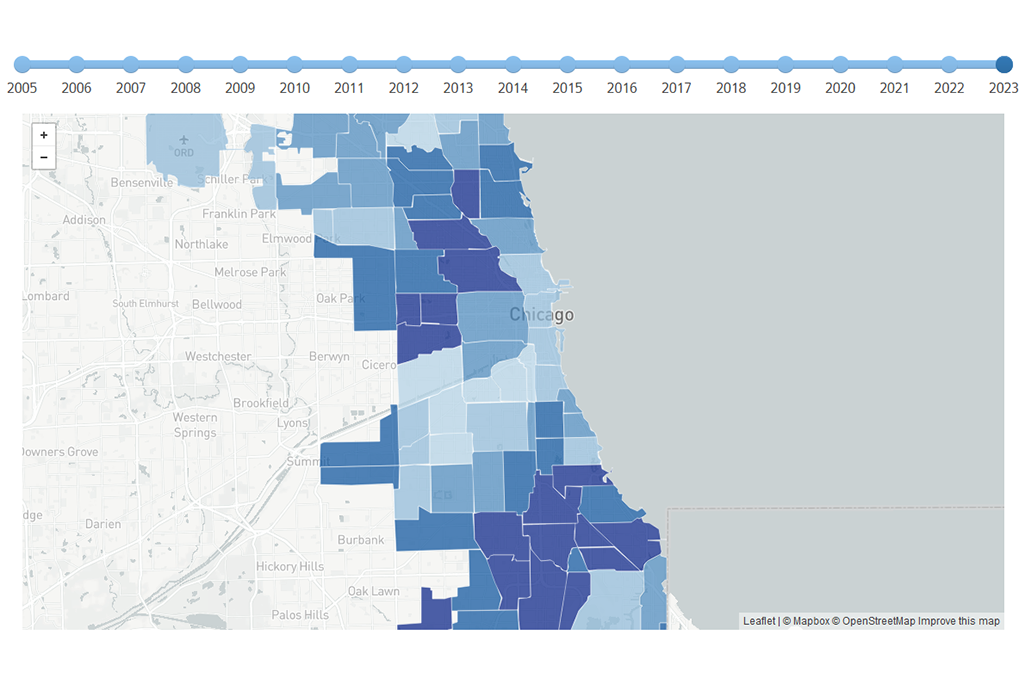Image source: Flickr Creative Commons / Eric Allix Rogers
A critical component of the Institute for Housing Studies’ (IHS) applied research model includes technical assistance to community groups and custom data analysis that illustrates different factors behind changing neighborhood housing and economic conditions. These data can provide a greater understanding of the reasons behind neighborhood change, provide evidence that amplifies the day-to-day experiences of community members, and inform community-led conversations to identify priorities and strategies.
For a decade, IHS has provided data and technical assistance to the Southwest Organizing Project (SWOP) in Southwest Chicago. This blog highlights some of our recent work and how it has been used by SWOP. To explore previous blogs in this series, such as our recent post about our partnership with Communities United to inform the organization’s affordable housing initiatives, click here.
About SWOP
The Southwest Organizing Project is a broad-based organization of 45 faith institutions, local schools, and other institutions in the Southwest Chicago communities of Chicago Lawn, Gage Park, West Lawn, West Elsdon, and Ashburn. The organization works on many initiatives in these communities, including housing assistance, violence reduction, access to education and financial resources, and protection of immigrants’ civil liberties. One of SWOP’s recent key housing initiatives is a partnership with United Power for Action and Justice and Brinshore Development to lead the Reclaiming Southwest Chicago project, a multifaceted initiative to strengthen community capacity through improved affordable housing, quality schools, and safe streets.
IHS has collaborated with SWOP for many years to provide a variety of data and inform the organization’s programs, initiatives, and outreach. Recently, IHS developed a data dashboard to provide SWOP with information on the economic, demographic, and housing market characteristics and COVID-19 related risk indicators in southwest side communities. Many of these data points were developed to help SWOP implement its Reclaiming initiatives in the aftermath of the foreclosure crisis and to answer key questions SWOP has encountered since.
Rebuilding after the Foreclosure Crisis
Chicago’s southwest side offers diverse communities and moderate-priced homes, which made the area a popular place to buy a home before the 2007-2008 financial crisis. However, these communities were also the target of risky and predatory lending practices, including subprime loans.
“It was a neighborhood that anybody could sort of see themselves living in,” said Chris Brown, the Director of Operations at SWOP. “It was an ideal community for families who are looking to become homeowners, but it also made it an ideal target for unscrupulous real estate agents and actors to take advantage of families who are doing that.”
The southwest side was hit hard by the foreclosure crisis. More than 17,000 foreclosures were initiated on residential properties in SWOP’s communities since the crisis, and hundreds of buildings were left vacant. In Chicago Lawn, 42.3% of residential properties have had at least one foreclosure filing since 2005 – roughly double levels seen citywide.
Figure 1. Indexed Percentage Change in Residential Foreclosure Filing Activity in SWOP Community Areas, 2005 to 2019

Source: IHS Data Clearinghouse
SWOP began working to aid residents facing foreclosure, helping more than 650 families avoid foreclosures. However, SWOP and local institutions also saw a need to focus on vacant properties as the crisis evolved. “SWOP did - and still does to some extent - some work around foreclosure mediation to help families go through the court system and figure out ways not to lose their house,” said Brown, “but because there were so many abandoned buildings, we also knew we had to address vacant properties.”
In response, SWOP partnered with United Power for Action and Justice, a region-wide community organization, and Brinshore Development, a private developer, to begin the Reclaiming Southwest Chicago project. The project raised $15 million and began targeting a 20-block area in the community that had 93 vacant buildings. SWOP bought buildings in the area, rehabbed them, and turned them into affordable housing. Other developers eventually came in to rehab other properties in the radius. “We’ve taken it from 93 vacant buildings down to eight,” said Brown.
Above: Community members blessing SWOP's first Reclaiming Southwest Chicago project. Source: SWOP
Throughout this project, SWOP has relied on IHS housing data to understand changes in the local real estate market and how this activity compares to other neighborhoods and to the city as a whole. “IHS data has been really helpful in helping SWOP track the real estate market in the community. Are properties appreciating, are properties depreciating, are there lots of transactions, what kind of transactions are those?” said Brown.
In 2015, SWOP was looking for more information on cash buyers in the community. Several of the vacant buildings originally identified had been purchased, and organizations were nervous about large investors buying up properties. IHS found, however, that these properties were being purchased by private individuals. “They figured out that they were not institutional cash buyers, but actually individuals. So that was probably local Latino contractors who were buying properties and rehabbing them, which is a good thing,” said Brown.
With the original program’s success, SWOP and their partners expanded the Reclaiming Southwest Chicago project to tackle approximately 150 additional vacant buildings within an adjacent 74 block area, according to SWOP.
Expanding Work during COVID-19
IHS analysis of the preliminary economic and housing impacts of the COVID-19 pandemic showed that submarkets in SWOP’s communities have some of the highest shares of households potentially impacted by COVID-related job layoffs in the city.
Figure 2. Share of Working Households with at least One Member in a Vulnerable Occupation by PUMA in the City of Chicago

Note: SWOP communities are apart of the Englewood/Greater Grand Crossing Public Use Microdata Area (PUMA). Source: 2018 ACS Microdata, IPUMS USA, IHS calculations based on code developed by NYU Furman Center
Understanding the substantial impact COVID-19 can have on jobs and incomes on the southwest side has helped SWOP take an active role in administering aid and resources in the community. These efforts include the Communities Partnering 4 Peace program, which puts outreach workers and case managers on the street to aid in violence prevention, a Parent Mentor Program at local schools, and citizenship workshops for immigrants. “I think we're really clear that no matter how good the houses were, and how cheap they were, if the schools weren't good and the streets weren't safe, people wouldn't move into those buildings,” said Brown.
In some ways, SWOP’s usual work continued relatively unabated after the pandemic struck. The organization says it is finishing rehabbing 17 housing units and four commercial spaces for the Reclaiming campaign. In other ways, their work has shifted. Many organizing efforts have moved to Zoom meetings. SWOP has helped organize contact tracing and, more recently, vaccination sites on the southwest side. The organization has helped connect more than 1,000 families to free internet through the city’s Chicago Connected Campaign.
SWOP has also been approached by public and private funders to provide direct financial assistance to families. “We've now moved more than a million dollars to approximately 600 families to provide mortgage, rental, and utilities assistance, so that people could pay their bills during this period,” said Brown.
While foreclosure and eviction moratoriums have kept most families in their homes through the pandemic, it is uncertain how hard the southwest side will be impacted once these moratoriums are lifted. SWOP is also concerned about the impacts of the COVID-19 economic recession on smaller landlords and families, including those living in 2 to 4 unit buildings - IHS research has found that this housing stock was heavily impacted during the previous foreclosure crisis. While SWOP neighborhoods are largely single-family, in some subareas, as much as 30 percent of housing units are located in 2 to 4s.
To aid SWOP in its efforts to anticipate and mitigate foreclosures, IHS helped SWOP identify the top mortgage lenders in the neighborhood. Brown said it is important to know who is lending in the neighborhood to help negotiate and avoid foreclosures and vacancies once the moratoria expire.
Currently, no single lender has a large share of loans in the community. “So that's a slight change and means it's a little harder to identify who the big folks are that you could go to and negotiate arrangements around foreclosure,” said Brown. “In 2007-2008, there were fewer big banks to do a huge chunk of the lending or had a lot of loans here.”
Table 1. Top Mortgage Lenders in Chicago Lawn, Gage Park, West Lawn, and West Elsdon, 2019

Source: IHS Data Clearinghouse
Informing Targeted Outreach
SWOP is also interested in demographic changes in its target areas to identify new ways to prioritize its resources in changing communities. IHS provided data that shows stable population change, but significant shifts in population distribution by age and ethnicity.
While the SWOP area continues to have a larger share of children under the age of 18 compared to the city as a whole, its senior population has increased considerably. In 2010, people aged 65 and above comprised 7.4 percent of the community. In 2018, the same group comprised 10.1 percent.
Figure 3. Net Change in Total Population by Age in Chicago Lawn, Gage Park, West Lawn, and West Elsdon, 2010 to 2018

Source: 2010 and 2018 ACS 5-Year Estimates
SWOP has begun to conduct outreach in the community to raise awareness among older adults of senior or homeowner tax exemptions. IHS found that a larger than average number of families in the community were not taking advantage of these exemptions, which could have an impact on housing affordability for older adults that may have unique housing challenges.
“We've been doing a campaign to go out and identify those families and encourage them to apply for the exemption,” said Brown, “because that will be more money in their pocket.”
Looking Ahead
As SWOP continues its work in community reclamation and pandemic response, it hopes to retain its volunteers and partners who have helped throughout the pandemic. “Hopefully, as the pandemic winds down, we'll be trying to figure out how we move those folks into other kinds of activities that help benefit the community,” said Brown.
SWOP is also working with the Greater Southwest Development Corporation to build a permanent Financial Opportunity Center in the SWOP community. The center would provide resources on several topics, including housing, employment, and public benefits.
“We're in the process of working to open a housing center that would really offer people full-service access to credit counseling, mortgage counseling, job readiness, training, assistance in getting employment, and access to public benefits as a way to help strengthen the economic infrastructure in the community,” said Brown.
As IHS continues to partner with SWOP, we hope to continue learning about issues SWOP identifies and developing tools to help the organization support its community. In the process, these tools will help us identify changes in community housing dynamics across the region.
“It's really helpful to have folks who both have a 30,000-foot view of what's going on in the housing market in Chicago, but also have the knowledge and data about what's happening in our own community and work with us and talk to us about that,” said Brown.







